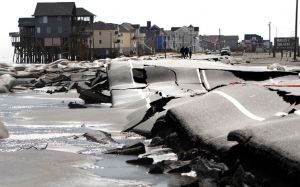Late last Friday, the U.S. State Department released its draft assessment of the proposed Keystone XL pipeline’s environmental impacts, marking a significant milestone toward the impending White House decision on the project’s fate.
It was a classic “taking out the trash” moment, a move canonized by the popular U.S. television political drama, The West Wing, as the go-to strategy when forced to make an announcement that could be damaging or unpopular. Releasing news in the last hours of the last day of the work week, as journalists and pundits are heading into the weekend, is widely seen as a tactic designed to minimize media coverage.
It’s not surprising that the U.S. Department of State chose this approach to release its draft supplemental environmental impact statement for the Keystone XL pipeline, given the public and political interest in this project.
 While the State Department assessed a range of potential environmental impacts related to the pipeline proposal, the question at the forefront of the debate has been to what extent filling Keystone XL with oilsands will cause more oilsands growth and contribute to climate change.
While the State Department assessed a range of potential environmental impacts related to the pipeline proposal, the question at the forefront of the debate has been to what extent filling Keystone XL with oilsands will cause more oilsands growth and contribute to climate change.
The State Department’s conclusion was surprising: Keystone XL would have no impact on the rate of oilsands growth. This conclusion was premised on there being little to no limitations on future oilsands production, and was based on a series of assumptions around expected oil prices, additional oil production in the U.S. and other transportation options (i.e. pipeline, rail, truck) that would be available were Keystone XL not built. Assuming the oilsands would be developed anyways, the specific environmental impacts (including greenhouse gas emissions) from filling Keystone XL with bitumen would be inconsequential.
But what if that assumption doesn’t hold true?
The U.S. State Department’s finding flies in the face of what oilsands industry advocates have been saying for years: that Keystone XL is critical for future oilsands growth.
We reached the same conclusion earlier this year; our analysis found that Keystone XL will be a key enabler of oilsands growth, and is by far the largest (830,000 barrels of oil per day) and most imminent of pipeline proposals.
Our research showed that filling Keystone XL with oilsands crude would require a 36 per cent increase in oilsands production and would create as much greenhouse gas pollution as putting 4.6 million cars on the road — an increase in emissions that is hardly inconsequential.
 Unlike the regionalized air and water impacts from oilsands development that largely stay within Canada’s borders, greenhouse gas emissions are an international problem — and the oilsands are the fastest-growing source of greenhouse gas emissions in Canada. While the costly impacts of climate change-fuelled weather events are increasingly being felt throughout the United States, Canada lacks a credible plan to address oilsands emissions. Considering that Hurricane Sandy and the yearlong drought in the Midwest/Plains combined cost the struggling U.S. economy $100 billion, the United States government would be right to pay attention to the climate impacts from the oilsands and the ability of the Canadian government to address the climate liabilities associated with rapid oilsands expansion. Approving the Keystone XL pipeline without any credible Canadian plan to reduce emissions runs counter to the renewed ambitions from the U.S. government to act on climate change and build a strong, competitive economy.
Unlike the regionalized air and water impacts from oilsands development that largely stay within Canada’s borders, greenhouse gas emissions are an international problem — and the oilsands are the fastest-growing source of greenhouse gas emissions in Canada. While the costly impacts of climate change-fuelled weather events are increasingly being felt throughout the United States, Canada lacks a credible plan to address oilsands emissions. Considering that Hurricane Sandy and the yearlong drought in the Midwest/Plains combined cost the struggling U.S. economy $100 billion, the United States government would be right to pay attention to the climate impacts from the oilsands and the ability of the Canadian government to address the climate liabilities associated with rapid oilsands expansion. Approving the Keystone XL pipeline without any credible Canadian plan to reduce emissions runs counter to the renewed ambitions from the U.S. government to act on climate change and build a strong, competitive economy.
Within the industry, the importance of Keystone XL to oilsands growth is widely recognized. Just ask major financial institutions and lenders to the oilsands industry, like CIBC and TD; executives from companies with significant oilsands holdings, like Imperial Oil and Devon Canada; even well-respected energy industry consulting groups, like IHS CERA, Canadian Energy Research Institute and Wood Mackenzie — all have raised concerns that current the lack of transportation options to carry oilsands to market will be a rate-limiting step for the oilsands industry.
Perhaps the U.S. State Department has additional information that the oilsands industry or their financiers were not able to obtain, but that’s unlikely. In the weeks ahead, as industry analysts and environmental groups comb through the 2,000-page tome that was released last week, more details of the assessment will undoubtedly emerge.
In particular, I will be looking for critiques on the State Department’s seemingly optimistic finding that rail is a cost-effective, large-scale alternative to pipelines and its conclusion that rapidly expanding tight oil production in the United States will have no impact on the economic viability of the oilsands industry. If the surge in tight oil production in the U.S. mirrors what happened to the profitability of the natural gas industry when shale gas production recently took off, then high-cost oilsands producers may be faced with more challenging economics going forward.
As the U.S. State Department emphasized last week, this new assessment is still only a draft version; within a week, a 45-day public comment period will commence when Canadians and Americans alike can provide input on the State Department’s assessment. A final assessment will then be issued, which will help the White House decide whether or not the Keystone XL pipeline is in the national interest of the United States.
While the State Department downplayed the role of the pipeline in increasing climate impacts, this issue remains the most contentious aspect of the Keystone XL proposal.
Canada’s lack of serious action on managing the climate liabilities from rapid oilsands development is not helping the pipeline’s odds of being approved or the long-term competitiveness of the industry. As U.S. Ambassador David Jacobson suggested last month, it’s high time the Canadian government directed the oilsands industry to improve its climate performance. Otherwise, Keystone XL may be the first in many attempts at exporting high-carbon energy to a market that’s moving in the opposite direction.
Nathan Lemphers was a senior policy analyst in the Pembina Institute's oilsands program, until 2013.



